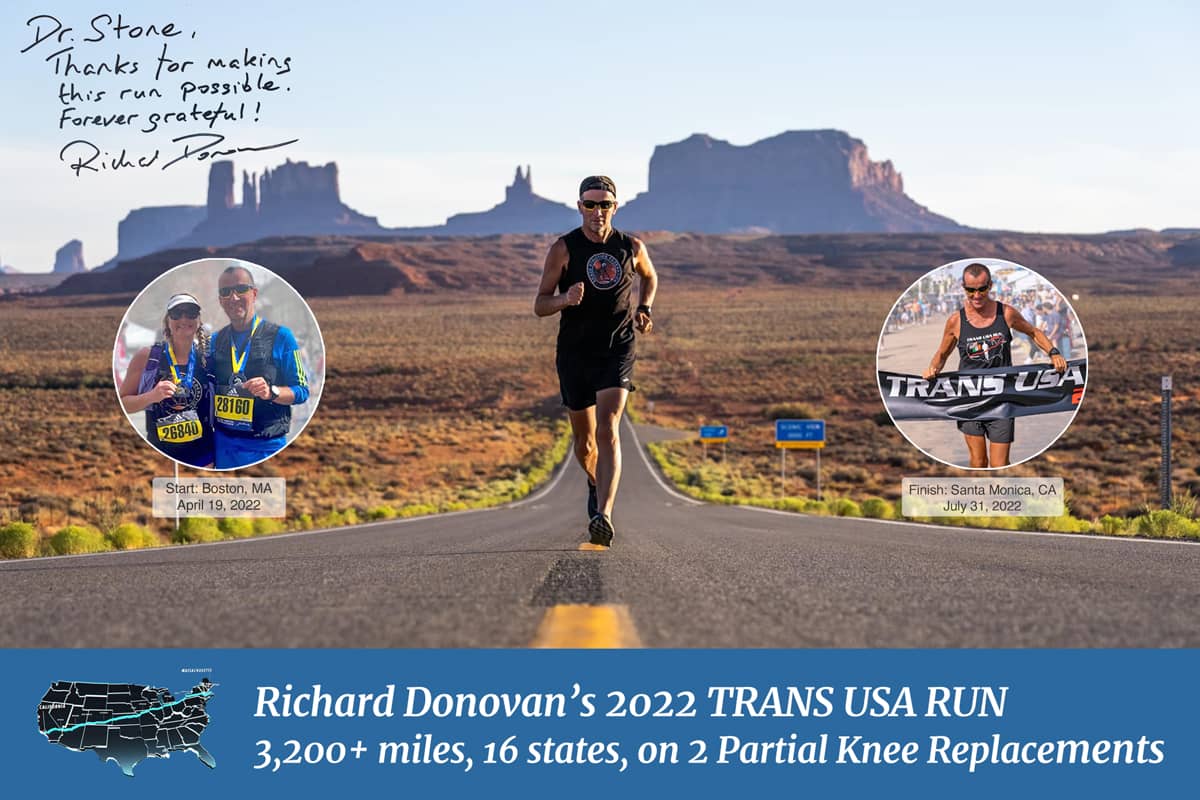Run, Baby, Run
We let our biologic joint replacement and our artificial partial and total knee replacement patients run after surgery. Why do we do this, when almost everyone else advises them not to? Here is the story.

Trans USA Run completion by ultra runner and bilateral partial knee replacement patient Richard Donovan.
Biologic knee replacement (BioKnee®) is our treatment for knees that have lost their articular cartilage, their meniscus cartilage, and sometimes their ligaments. We replace and regrow those structures.
Artificial knee replacement in this decade involves our use of CT scan 3D reconstructions of the knee, followed by robotically-guided joint replacement as an outpatient procedure. Due to the precision of the robotic guidance, no cement is required for the total knees. Since the patient’s bone grows into the components, loosening is far less likely to occur. Though partial replacements still require cement, robotic control permits a precision placement that balances the joint in three dimensions at the time of surgery. Such precise placement was never before possible.
Still, why let them run? The reality is that most patients who have finally made it to surgery for an artificial joint gave up running years ago for a host of physical reasons–and not just because of their knee. They are not likely to return to running even if the knee joint is repaired. The remainder of my driven runners certainly can return to running—and they should. Here is why:
First, when I ask my colleagues at major orthopaedic meetings if they have seen any patients who have loosened their artificial joint replacements while running, none raise their hands. There must be a few somewhere, but it is not common.
Second, resistance exercise is the only way to build bone. If you tell patients to go home and rest their knee and not load it, they become osteoporotic and lose muscle—never mind getting depressed from not exercising.
Third, CT 3D planning plus precision robotic insertion, combined with a number of surgical “tricks” from experience with high-level athletes, permits us to place these implants so that they should be able to absorb the loads produced by running. This is especially true if the running technique is improved to include short strides, soft surfaces, and mid-foot landings with gait training.
Fourth, at least in the case of biologic joint replacements, the whole reason most people seek out meniscus replacement and cartilage regrowth procedures is to remain athletic and delay the time of artificial joint replacement. Our recent data in patients over the age of 50 who have received meniscus replacement and returned to sports demonstrated a minimum of 8 years delay of joint arthroplasty, with 55% of the patients never coming back for artificial joint replacement.
Patients who want to run after joint replacement can if all the boxes are checked: careful precise surgery, great training, thorough physical therapy, and the right mindset of both the patient and the surgeon.
Running on a Total Knee Replacement
After a total knee replacement and tendon repair, Darren has been running 30-35 miles per week on his replaced parts and is still working to run faster and further.

